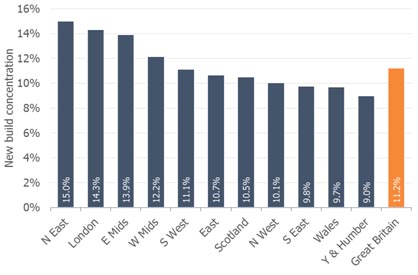UK property market relying more on new build homes
Posted 24 February 2016 by
Keith OsborneAnalysis from industry experts Hometrack reveals that new homes starts are accounting for a higher proportion of property sales now than at any time over the past 20 years.
Historically, new homes have consistently accounted for 10% of all property sales across the UK, but currently that figure stands at 11.2%, as housebuilders and developers respond to demand from homebuyers and the government to increase availability.
 Hometrack’s findings, from Department of Communities and Local Government (DCLG) data, shows the distribution of new build homes varies from region to region, with the North East and London seeing the highest proportion of new homes activity, at 15% and 14.3% of the market respectively. Wales (9.7%) and Yorkshire and the Humber (9%) have the lowest proportion.
Hometrack’s findings, from Department of Communities and Local Government (DCLG) data, shows the distribution of new build homes varies from region to region, with the North East and London seeing the highest proportion of new homes activity, at 15% and 14.3% of the market respectively. Wales (9.7%) and Yorkshire and the Humber (9%) have the lowest proportion.
Drilling down the data, Hometrack found 58local authorities (15% of the total) where new builds starts account for 20% or more of property transactions. In the London Borough of Newham, there were more new homes started in the last year than there were other property sales, giving the borough a concentration ratio of 104%, far ahead of the next two London boroughs, Lambeth (38%) and Southwark (36%). Outside London, Cambridge (42%), Ribble Valley (42%) and Midlothian (39%) saw the highest concentration on new build homes.
The regional differences across the country can be explained by a number of factors, including land availability, housing demand and local planning requirements.
The DCLG data shows new private housing starts are up by 3.1% in the last year and by 33% over the last three years. The Help to Buy scheme has been used for 27% of all housing completions in the last year.
Alex Rose, managing director of data and analytics at Hometrack says: “These figures show how the delivery of new housing is not evenly distributed across the country as developers balance the relative strength of local housing markets and demand for new housing against land availability and planning constraints.
“The challenge for housebuilders is that some local markets are more new build reliant than others, which will impact assumptions on sales rates and assessment of demand for housing. This is particularly important given the proposed transition from Help to Buy to Starter Homes in 2016 where there is overlap between the two schemes.
“There are many parts of the country where new private housing starts as a proportion of sales are well below the national average. 102 local authorities have a new build concentration of less than 5%. “